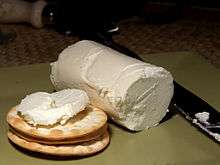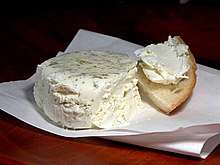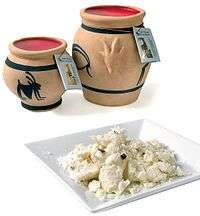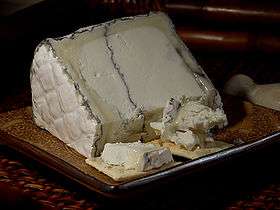Goat cheese
Goat cheese, goats' cheese, or chèvre (/ˈʃɛvrə/ or /ˈʃɛv/; from the French word for goat), is cheese made from goat's milk. Goat cheeses are made in a wide variety of styles, from soft fresh cheese to hard aged cheese.

Properties
Cow's milk and goat's milk have similar overall fat contents.[1] However, the higher proportion of medium-chain fatty acids such as caproic, caprylic and capric acid in goat's milk contributes to the characteristic tart flavor of goat's milk cheese. (These fatty acids take their name from the Latin for "goat": capra.)[2]
Goat cheese has been made for thousands of years and was probably one of the earliest made dairy products. In the most simple form, goat cheese is made by allowing raw milk to naturally curdle, and then draining and pressing the curds. Other techniques use an acid (such as vinegar or lemon juice) or rennet to coagulate the milk. Soft goat cheeses are made in kitchens all over the world, with cooks hanging bundles of cheesecloth filled with curds in the warm kitchen for several days to drain and cure. If the cheese is to be aged, it is often brined so it will form a rind, and then stored in a cool cheese cave for several months to cure.
Goat cheese softens when exposed to heat, although it does not melt in the same way many cow cheeses do. Firmer goat cheeses with rinds are sometimes baked in an oven to create a softer, more viscous texture.
List of goat's milk cheeses by region
East Asia
China
- Rubing is a fresh goat cheese from Yunnan Province, resembling the Indian paneer, a cow's cheese.
- Shosha – a pungent cheese and staple food in Tibetan cuisine of the Tibet Autonomous Region that is often made from animals suited to the climate such as goat and yak.
Japan
- Yagi Cheese is a goat cheese made in Japan.
Europe
Eastern Mediterranean
France
France produces a great number of goat's milk cheeses, especially in the Loire Valley and Poitou, where goats are said to have been brought by the Moors in the 8th century.[3] Examples of French chèvres include Bucheron, Chabis, Chavroux, Clochette, Couronne Lochoise, Crottin de Chavignol (largest produced goat cheese AOC), Faisselle, Montrachet (Burgundy), Pélardon, Picodon, Pouligny Saint-Pierre, Rocamadour, Sainte-Maure de Touraine, Chabichou du Poitou, Valençay, and Pyramide.
It is sometimes served hot as chèvre chaud.
Greece
- Feta, mizithra and anthotyros are traditionally made from goat's milk.
Ireland
- Tullyboy goat cheese is a hard mature cheese made from pasteurized milk.
Italy
- Caprino is a term encompassing at least 33 different goat's milk cheeses produced in Italy, equivalent to the French chèvre
- Acidino (tr. slightly acid), produced in Veneto
- Agrì di Valtorta, produced in Lombardy
- Formaggio di capra di Lagundo (or Algunder Ziegenkäse), produced in South Tyrol
- Canestrato di Moliterno Stagionato in Fondaco, produced mixing sheep and goat milk in Apulia and Basilicata
- Cavrin (or Cevrin) di Coazze, produced in Piedmont
- Ircano, produced in Sardinia
- Salignon, a smoked cheese produced in the lower Aosta Valley
Malta
- Ġbejna is a goat (or sheep) soft cheese. Various types are found which include; fresh (friski or tal-ilma), sundried (moxxa, bajda or t'Għawdex), salt cured (maħsula), peppered (tal-bżar) seasoned (imħawra).
Netherlands
- In the Netherlands there are several small goat-cheese farms. The Westerkwartier, the region west of the city of Groningen, has a relatively large concentration of organic goat-cheese farms. Well known goat cheeses from this region are Machedoux and Quiorio, brie-like cheeses served in restaurants all over the Netherlands and in Belgium and northern Germany. In other parts of the Netherlands, goat cheese is usually made in the Gouda style.
Norway
- Geitost, which means goat cheese, is brown and made from goat milk and whey. You can also buy other brown cheeses, for example Brunost ("Brown cheese") which are made from cow milk whey, goat milk whey or a combination of both.
- Snøfrisk is a fresh goat milk cheese that comes in different varieties including natural, chanterelles, herbs, and various other additions.
- Recently a firm white goat cheese was also made available in supermarkets.
Spain
- Mató is a Catalan fresh cheese made from cow's or goat's milk.
- Garrotxa is a firm goat's cheese originally from Garrotxa in northern Catalonia.
- Nevat, a soft-ripened goat's cheese from Catalonia.
- Majorero cheese is a goat milk cheese from the Canary Island of Fuerteventura.
United Kingdom
- St Helen's Farm produces a mild and a mature goats’ milk cheddar.
- Pantysgawn is a Welsh goat's milk cheese.
- Capricorn (cheese) is a Somerset, UK goat's milk cheese.
- Gevrik is a Cornish goat's milk cheese. The word gevrik meaning 'little goat' in the Cornish language.[4]
- Tesyn is a Cornish smoked goat's milk cheese.[5] Tesyn means 'cake' in the Cornish language.[6]
North America
United States
- Kunik is produced at Nettle Meadow Goat Farm in Thurman, New York and made from goat and Jersey cow milk blend, mold-ripened with similar properties to Brie.
- Humboldt Fog is a mold-ripened goat cheese with a central line of edible white ash made in California by Cypress Grove Chevre
Oceania
Australia
- Drysdale Goat Cheese from the Bellarine Peninsula, Victoria.
- Holy Goat from central Victoria.
- Main Ridge Dairy from the Mornington Peninsula, Victoria.
- Meredith Dairy from the western districts of Victoria.
- Nimbin Valley Dairy from New South Wales.
- Tolpuddle Goat Cheese and Farm Foods from North East Victoria.
- Yarra Valley Dairy from Victoria.
South America
Venezuela
West Asia
Turkey
- Tulum Cheese is a goat cheese made in Turkey.
- Sepet Cheese and Kaşar Cheese are also produced from goat milk and marketing as Goat Sepet Cheese and Goat Kaşar Cheese.
- Beyaz Peynir ("White Cheese" in Turkish) is a brine cheese produced from sheep, cow, or goat milk and when it is made of 100% goat milk, then it is also categorized as Goat Cheese in Turkey and named as Coat White Cheese.
- Ezine Cheese, originating from Ezine, Çanakkale, is a type of Beyaz Peynir including at least 40% goat milk according to the geographical protection rules.[8]
References
- "Content of Milk by Species". havemilk.com.
- "Capric acid", Chemical LAND21.com. Accessed 26 June 2008.
- "Get your goat you've pulled...", Impressions Magazine, n.d. Archived 2008-11-13 at the Wayback Machine Accessed 26 June 2008.
- "Gevrik Cheese," practicallyedible.com. Archived 2008-03-13 at the Wayback Machine Accessed 26 June 2008.
- "BBC NEWS – UK – England – Cornwall – Smokehouse emerges as big cheese".
- "Newquay's Finest – Accommodation, Clubs and Surfing Events". Archived from the original on 2013-11-08. Retrieved 2013-10-23.
- Idalia De León. "Estampas". El Universal.
External links
- Goat Dairy Foods from the University of California, Davis Dairy Research and Information Center
- National Public Radios covering of a local news case from Norway: Burning Cheese Closese Norwegian Road For Days



